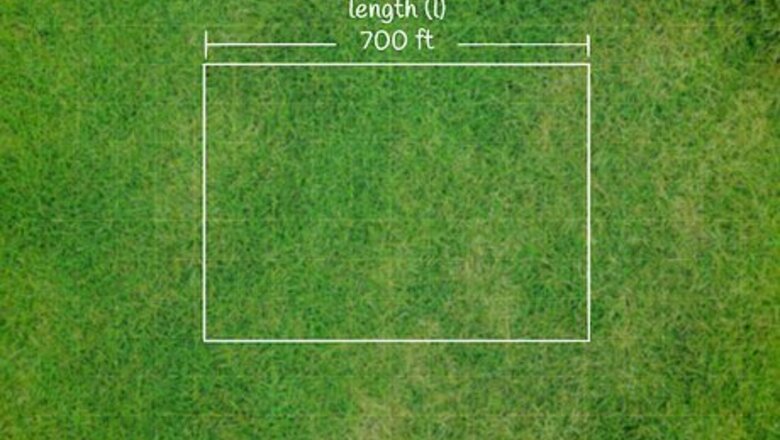
views
Calculating Acreage for Regularly Sized Land Parcels
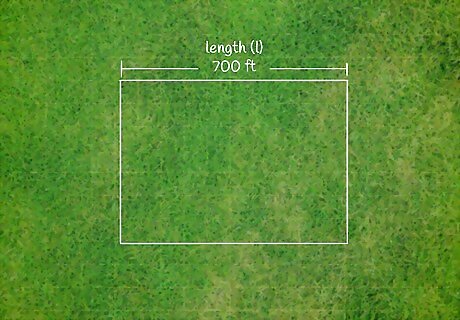
Determine the length of the area. To calculate the acreage of a parcel of land you first need to calculate its area in another unit of measurement, which you can then convert into acreage. This is most commonly done with feet, yards, or meters. If the area you are trying to measure is of a regular shape, with four sides, such as a square of rectangle, the calculations are relatively straightforward. The first thing to do is measure the length of the area. Length is the longest dimension of your property
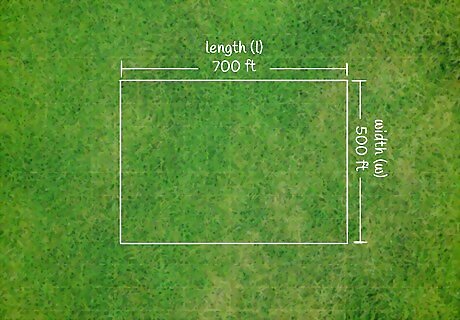
Measure the width. One you have the determined the length of the area you will need to measure the width of the area. The width might also be referred to as the breadth and is the horizontal line across the shape you are trying to measure. If you are trying to measure a large area outside consider using a surveyor's wheel that you can push along as you walk. Width would be the shorter dimension of your property.
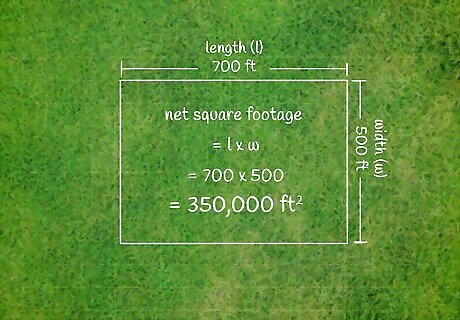
Multiply the width by the length. In order to calculate the square size you need to multiply your recorded height by width. Be sure that you measured both using the same unit of measurement otherwise the calculation won't work. Once you have multiplied these figures you will have the square size. For example, an area that has a width of 500 feet, and a length of 700 feet would be calculated by multiplying 500 by 700. In this case the area is 350,000 square feet. Once you have the total size in square feet, meters or yards you need to convert this into acres. Multiplying length by width gives you the area, or the space inside the boundary of your property. Acreage is simply one measure of area. An easy way to remember the formula for area is A (area) = L (length) x W (width), which is the exact calculation done in this step.
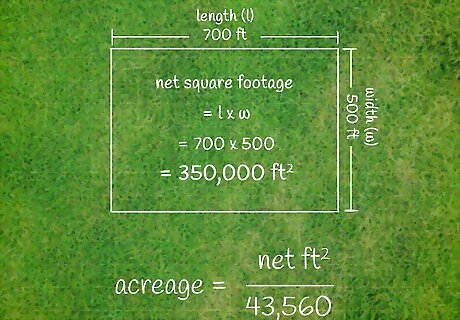
Understand how to convert the measurements into acres. Once you know the size of your land parcel in an alternative unit of measurement you can convert this into acres with some relatively straight forward arithmetic. In order to do this you need to known the conversion values for whatever measurement you are using in relation to acres. Some of the most commonly used conversion rates include: 1 acre = 4840 square yards. 1 acre = 43560 square feet. 1 acre = 4046.8564 square meters.
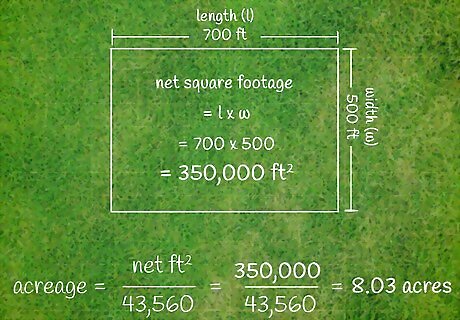
Make the calculation. To convert the total size from square feet, yards, or meters there is a simple calculation you need to complete. All you need to do is take the total size in square yards, meters, or feet and divide it by the conversion rates above that are relevant to that unit of measurement. For example, if your parcel of land is 50,000 square yards you can determine its acreage by dividing 50,000 by 4840. The answer is 10.33. So 50,000 square yards is equivalent to 10.33 acres. You can repeat this with the other units of measurement. 50,000 square feet is 1.147 acres. 50,000 square meters is equivalent to 12.35 acres. There are many online tools that can make this conversion for you if you have the size in an alternative unit of measurement. Carefully measure property lines for fencing. "After reading through the steps on measuring acreage, I realized I needed to be much more careful in mapping out our property lines before installing a new fence. Taking precise measurements at the corners and marking them clearly is going to ensure the fence sits right where it should without encroaching on the neighbor's yard. This advice has been invaluable." - David D. Connect with an expert to gain technical knowledge. "As someone new to land surveying, I deeply appreciated being able to connect with an expert like you. I would never have known about calculating the diagonal distances or angles between points on an irregular plot of land, which helped me map out the boundaries much more precisely. Getting quality advice from someone knowledgeable was so helpful." - Jhonatan R. Finally, understand the definition of an acre. "After watching countless YouTube tutorials and reading other articles online, I was no smarter about what actually constituted an acre than when I started. But after carefully working through your step-by-step guide, I finally understand not only the definition of an acre but also how to measure it practically. Thank you for the clear explanations!" - Jerry T. Succeed at gardening on a small plot. "Your clear instructions on calculating acreage allowed me to precisely measure my backyard vegetable garden plot. Knowing the exact square footage has helped me maximize the space and succeed at gardening, even on a small parcel of land. I can now plan and plant efficiently." - Decklan E. We want to hear from you! Advice from our readers makes our articles better. If you have a story you’d like to share, tell us here.
Determining Acreage for an Irregular Four-Sided Shape
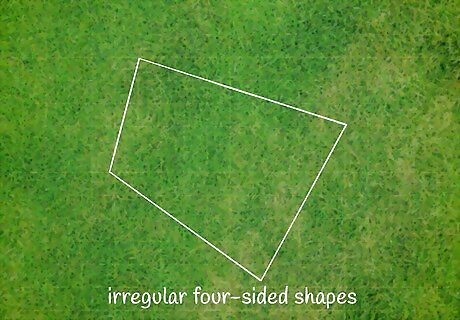
Understanding irregular four-sided shapes. If your land has four equal sides, it is a square, and if all four corner angles are right angles (90 degrees) it is a rectangle. In these cases, the first method will work perfectly. Sometimes, however, your land may have four straight sides, but the corners may have angles other than 90 degrees (often different for each corner). This is known as an irregular four-sided shape. In this case, calculating acreage gets more complex because you need to determine the area of a shape with often four different angles at each corner. A shape with four sides is known as a quadrilateral, and this not only includes right-angled shapes (like squares and rectangles), but also other shapes without right angles like kites, parallelograms, trapezoids or rhombuses.. Since there are four types of quadrilaterals that are not squares and rectangles, there are also separate formulas for each type. For this reason, the easiest way to calculate the acreage of your property if it has an irregular shape is to use an online calculator. Your job is therefore to determine the inputs for the calculator. A Google search for "area of a quadrilateral" calculator will yield several results to choose. You may need to convert the results into acreage at the end (if the numbers you input are in square feet, yards, or meters).
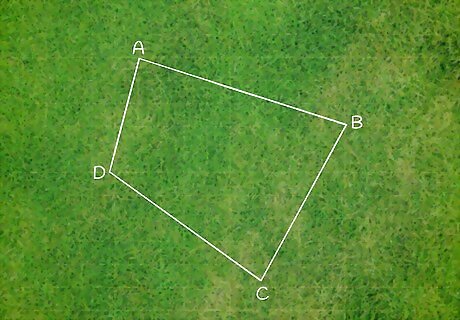
Designate the corners of the area. Calculating the size of an area of an irregular shape is more complicated than with a more straightforward square or rectangular shape. The same principles of determining the size in square feet, yards or meters and then converting it to acres still apply, but calculating the size is harder when you cannot simply multiply length by width. Begin by designating the corners of your shape A, B, C and D. Start by marking one corner as A, and then go around the shape clockwise marking the other corners B, C and D.
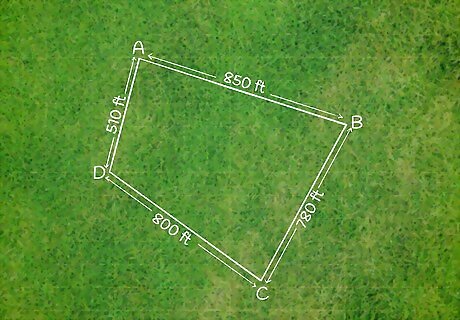
Measure the distances between the points. Once you have marked the corners of the shape with the letters you need to begin your measurements. First of all measure from A to B and record it. Then measure B to C, and then C to D before the final measurement of D to A. Ensure you make clear records of these measurements and that you are always using the same unit of measurement.
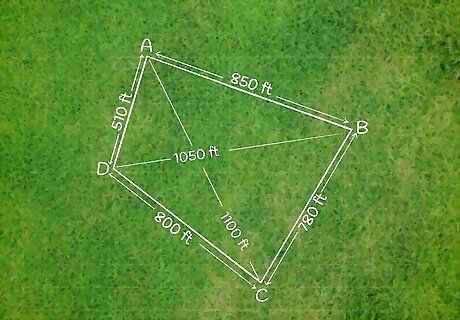
Calculate one additional value. Calculators often require one additional value other than the distance between the points. While it varies between calculator, they often require the diagonal distance from point A to C, or from B to D. On occasion (depending which calculator you will use), the calculator will ask for one of the angles. This could be an easier choice if you only have a surveyor's wheel or tape measure.
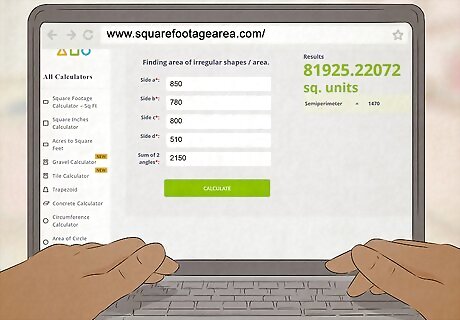
Enter the information into an online calculator. Once you have made these calculations you need to enter these details into an online tool which will determine an approximate acreage based on this information. It's important that you take care with the measurements as the accuracy of the calculation depends on the accuracy of the information you supply. This particular calculator simply requires the distances between points, and the diagonal distances between A to C or B to D. If the results from the calculator are not in acres, use the conversion rates to convert them to acres from what ever unit you input into the calculator.
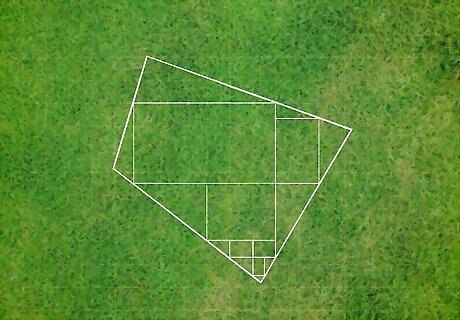
Break the shape into smaller rectangles. You can calculate the acreage of an irregular shape without the use of an online tool by splitting the area into smaller constituent areas. If possible, split the space into a regular shapes such as rectangles or squares. You will need to measure the area of each of these constituent spaces individually and then add them together to determine the total acreage. This would be most easily achievable if you have a clear and accurate map of the area you are trying to calculate the acreage of. It would be a good idea to try both methods for calculating acreage for an irregularly sized space and checking your results. This is simply the same process used in Method One, except you need to add the area of all the squares together at the end.


















Comments
0 comment